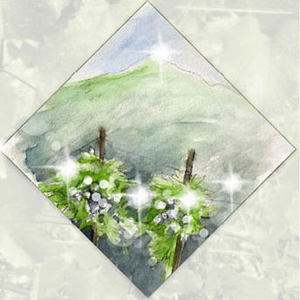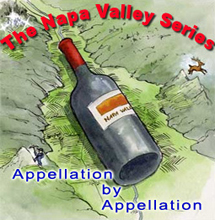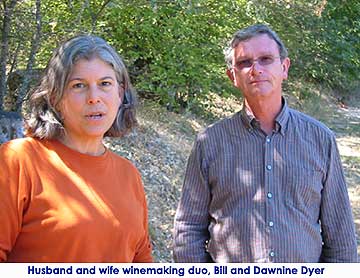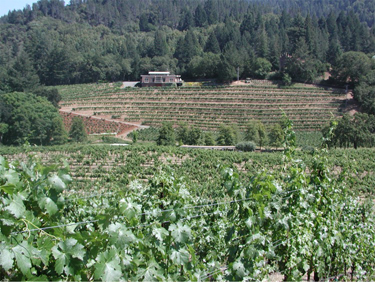

The Diamond Mountain District takes in many micro-climates and terrains but the diamond in the rough is the rich volcanic soil.
Diamond Mountain District ~ Napa Valley (AVA)
Diamond Mountain: A gem of a place
In this last chapter of The Napa Valley Appellation Series, Alan Goldfarb goes exploring for jewels in the Diamond Mountain District and finds exquisite Cabernet Sauvignons in an appellation tucked away far from the Napa Valley floor.
by
Alan Goldfarb
January 11, 2008
 hat Al Brounstein meant when he referred to “this thing” was the beginning of growing world-class grapes in the modern era of Diamond Mountain. That was in 1968 when Brounstein planted his property to three different vineyards, which eventually produced a trio of what would become three of the greatest – and most expensive – Cabernet Sauvignon-based wines from the Napa Valley, wine that he called Diamond Creek.
hat Al Brounstein meant when he referred to “this thing” was the beginning of growing world-class grapes in the modern era of Diamond Mountain. That was in 1968 when Brounstein planted his property to three different vineyards, which eventually produced a trio of what would become three of the greatest – and most expensive – Cabernet Sauvignon-based wines from the Napa Valley, wine that he called Diamond Creek.
Brounstein, who died at age 86 in 2006, eventually would plant a fourth vineyard on the property, which is located in the
 neighborhood that Bill Dyer – who has worked with Diamond Mountain fruit longer than anyone (31 years) – calls the “filet” of the region.
neighborhood that Bill Dyer – who has worked with Diamond Mountain fruit longer than anyone (31 years) – calls the “filet” of the region.
Dyer was the winemaker for Sterling Vineyards from ’77 to’96 when the winery bought what would be called Diamond Mountain Ranch. That vineyard, the largest on Diamond Mountain at about 120 planted acres, sits near the top of the AVA (American Viticultural Area) at an elevation of more than 2,000 feet. Wines from that height possess different attributes than the wines from lower elevations at around 500 feet from where Dyer calls the heart of the appellation. That’s where his Dyer Vineyards, Diamond Creek, Diamond Terrace, von Strasser, and Reverie reside.
According to Dyer and his wife Dawnine - who was the winemaker and vice president of Napa sparkling wine house Domaine Chandon for nearly a quarter-century - wines from their neighborhood or “filet” generally exhibit disparate subtleties compared to wines from the higher elevations of the Diamond Mountain District, due to climatic and soil differences.
On top, where Sterling’s vineyard and the vineyard of Constant Diamond sit, the soil profiles can be quite loamy because of remnants from a ancient river which once ran through the area.
 “Down here,” in his corner of a little valley of Diamond Mountain, the soils, according to Bill Dyer, are “strictly volcanic.”
“Down here,” in his corner of a little valley of Diamond Mountain, the soils, according to Bill Dyer, are “strictly volcanic.”
The Diamond Mountain District obtained AVA status in 2001. The region, with 5,000 acres, is situated between St. Helena and Calistoga in the northernmost part of the Mayacamas Range, which forms the western rim of the Napa Valley. There are a little more than 500 acres planted to grapes – mostly to Cabernet – produced by less than a dozen wineries and a little more than 20 growers (including Hall of Fame pitcher Tom Seaver).
But Dyer doesn’t wish to give the impression that those growers and wineries produce wines that are monolithic.
“I don’t want to emphasize (the differences) between the top and bottom (of the mountain). (But) there are some differences. Sometimes wines from deeper soils (from on top of DMD) can be more mint-y and herbal. (But) nature doesn’t divide it up that neatly … It’s vineyard by vineyard.”
However, down in Dawnine Dyer’s neck of the woods, “Typically, the wines are darker, with black fruit that lean more toward stone fruit and away from berry,” she says. “We have more dark cherry, anise, licorice, and chocolate.”
More important, according to her husband, the wines from the DMD differ from those from nearby Spring Mountain and the more southerly Mount Veeder (the western hillside areas of the Napa Valley).
Take the wines from Mount Veeder, for instance, where it’s cooler than the DMD. Of these, Bill Dyer says “Those wines are a little bit leaner, more mint-y, and herbal”.

While volcanic soils are prevalent through most of DMD, they are particularly abundant in the Volcanic Hill Vineyard of Diamond Creek Vineyards shown here.
As a point of emphasis, Dyer is somewhat emphatic about dispelling the conventional wisdom that because the DMD is in the northern part of the Napa Valley, it will necessarily be warmer than other areas.
In making his point, Dyer reminds the listener that the DMD is 40 miles north of the San Francisco Bay and 40 miles east of the Pacific, both of which have cooling influences, especially the latter.
“It turns out that (the idea that the) farther north (one goes in the Napa Valley) the warmer it is, isn’t necessarily true,” he contends. “Calistoga (which is two miles north of the DMD) doesn’t always turn out to be hotter.”
That’s because there’s what Dyer describes as a “little saddle” north of Diamond Mountain that benefits from the drainage from the Russian River, which is on the other side of the range, in Sonoma County. That saddle also allows in some fog from the ocean, which manifests in marine influences.
“It’s the same climate that’s driving coolness from the Russian River,” he believes.
While Brounstein’s contention that the DMD should stick to one variety – Cabernet Sauvignon – has generally been adhered to, other grapes have been planted up there in recent years. While Chardonnay is at a minimum, Rudy von Strasser is set to release the first DMD Grüner Veltliner, the Austrian varietal that he planted a couple of years ago. Syrah, too, is beginning to gain a foothold, as is Cabernet Franc.
Sterling’s Cab Franc does really well, as does the Dyers’, which comprises only 17 percent of the plantings on their miniscule 2 ½-acre plot.
Cab Franc, believes Dawnine, gives their Cabernet Sauvignon (about 400 cases, which sells for $75 a bottle) an “aromatic lift and a refined edge with beautiful violet characters with never any of the greenness that sometimes you get out of Cab Franc.”
Merlot, however, which is used most often in Cab blends, is the DMD variety which doesn’t do as well as in other regions of the Napa Valley.
“We don’t see a lot of successes with Merlot,” acknowledges Dawnine. In fact, the Dyers have extricated their Merlot and
 READER FEEDBACK: To post your comments on this story,
click here
READER FEEDBACK: To post your comments on this story,
click here
Print this article | Email this article | More about Diamond Mountain District ~ Napa Valley | More from Alan Goldfarb















